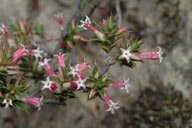In Flower This Week
A news sheet prepared by a Gardens' volunteer.
Numbers before each plant refer to temporary IFTW labels in the gardens.
Numbers in square brackets [ ] refer to garden bed Sections. Plants in flower are in bold type.
View past issues of 'In Flower This Week'.
24 June 2015
Leucopogon neoanglicus click for larger image |
Today we will visit the Rock Garden.
- Between the two entrances to the Rock Garden on your right is Guichenotia ledifolia [Section 4], with grey-green foliage covered in masses of dusty pink five-petalled flowers with maroon centres. It is native to south western Western Australia.
- Go through the right-hand entrance to see on the left Correa pulchella ‘Pink Mist’ [Section 15s], with dainty pink bell flowers on a small bush. The original material of this cultivar was collected from a wild population of Correa pulchella on the southern Yorke Peninsula of South Australia. It was selected for its compact habit and flower colour.
- Also on your left is Banksia fraseri var. fraseri [Section 15p], a small shrub with finely divided foliage and small, domed brown-gold cones. It is endemic to southwestern Western Australia.
- Turn right to see on the left Leucopogon neoanglicus [Section 15k] with dark red, fine-leaved foliage and pink tubular bell flowers. This plant grows on rocky outcrops and ridges, usually in sandy soil, in New South Wales and Queensland.
- Also on your left is Zieria adenophora [Section 15k], with dark red foliage and small white flowers. It is only found at one site near Araluen, New South Wales, where fewer than two hundred plants are known to occur. Now turn back and bear right up the hill.
- On your left is Banksia spinulosa ‘Birthday Candles’ [Section 15l], a dense bush with attractive needle foliage and short yellow cones with rusty red styles.
- Also on the left is Banksia integrifolia subsp. integrifolia [Section 15l], or Coast Banksia, a vigorous mound of foliage and flowers. It has dark green silver-backed leaves and plenty of short greenish-yellow cones. It grows naturally along the coast of eastern mainland Australia.
- Turn left and continue straight ahead to see on your left Banksia ‘Cape Patterson Dwarf’ [Section 15q], a small bush with silver-backed, dark green foliage and lime-yellow cones. Now turn back and go left across the plank bridge.
- On the left is Eremophila subfloccosa subsp. subfloccosa [Section 15d], a low spreading shrub with furry silver foliage clasping the stem and green tubular flowers. It is found naturally in central and southern Western Australia and South Australia.
- Also on your left is Chorizema cordatum [Section 15d], or Heart-leaved Flame Pea, a showy plant with vivid orange/red flowers on a weeping shrub with bright green prickly foliage. It grows naturally in the moist southwestern parts of Western Australia.
- On your right is Homoranthus darwinioides [Section 15f], with dark purple-grey foliage and pendulous white flowers that turn reddish with age. This plant is endemic to New South Wales
- Bear left down the hill to see on your left Grevillea manglesii subsp. ornithopoda [Section 15d], or Birdsfoot Grevillea, a large open shrub with white pincushion-like flowerheads all along the stems. It is native to Western Australia.
- Banksia spinulosa ‘Honeypots’ [Section 15d], also on the left , is a medium-sized bush with fine, upright toothed foliage and many gold cones.
- Correa ‘Ivory Bells’ [Section 15d], is on your left with creamy bell flowers and dark green silver-backed leaves. This very floriferous cultivar originated in San Francisco, USA and is probably a hybrid between Correa alba and C. backhouseana.
- On your right is Grevillea lanigera [Section 15c] with grey-green foliage and pink and cream flowers on a low bush. It is commonly known as Woolly Grevillea, and is endemic to Victoria and New South Wales.
Rosalind Walcott
![Director of National Parks [logo]](../../../../images/dnp_90px.gif)







